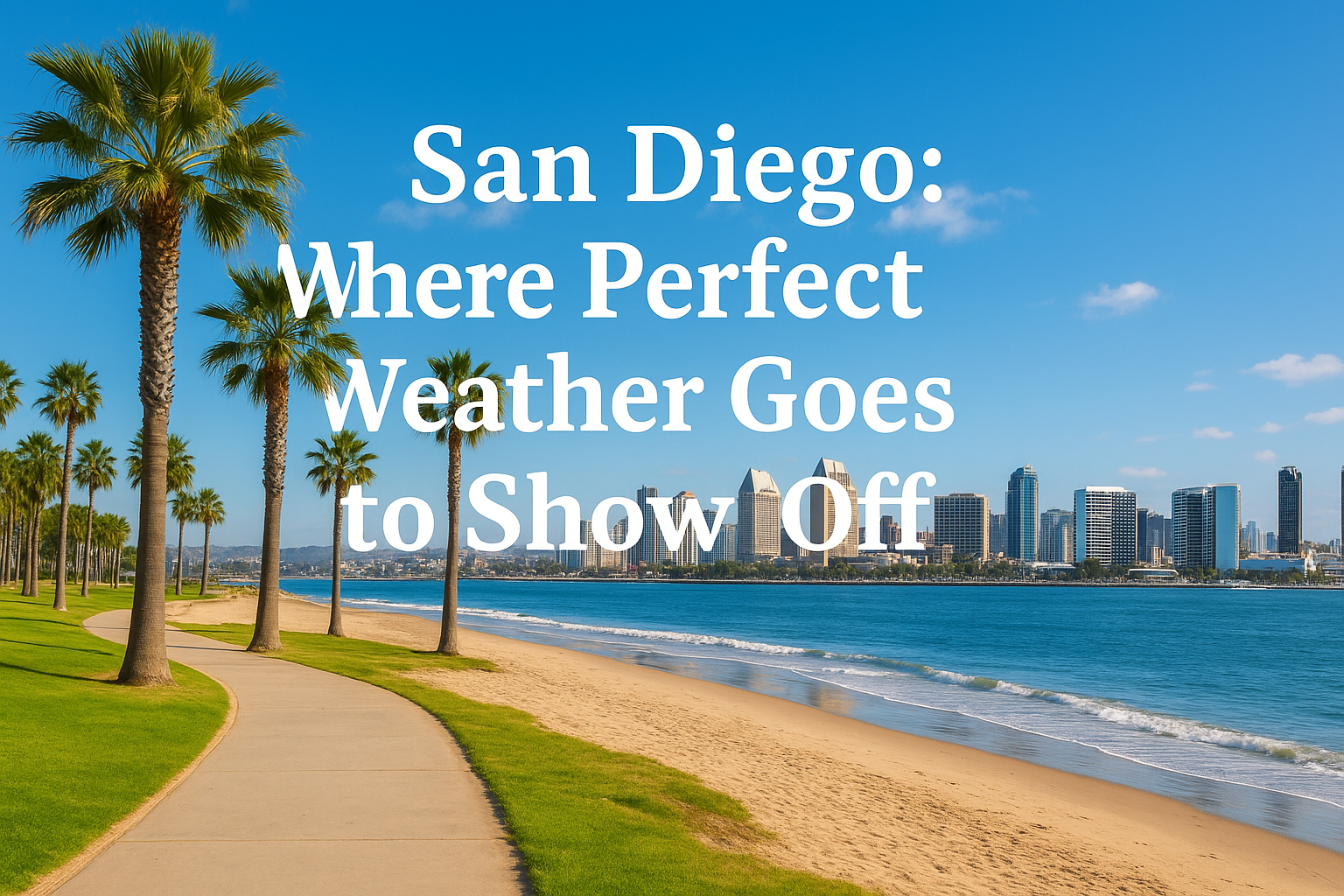So my wife and I decided to escape the swamp-like embrace of Baton Rouge humidity and visit San Diego, California, a place that bills itself as having “America’s Finest City” weather. Coming from Louisiana, where we consider any day under 90% humidity a gift from God, this seemed like an outrageous claim. Turns out, they weren’t kidding. San Diego has the kind of weather that makes you suspicious, like it’s too good to be true and probably involves some kind of Faustian bargain with the Pacific Ocean.
The Weather Situation (A.K.A. Meteorological Arrogance)
San Diego maintains a constant temperature of roughly 72 degrees with sunny skies approximately 260 days per year. For those of us accustomed to Baton Rouge’s seasonal variations of “Hot and Humid,” “Hotter and More Humid,” “Surface of Venus,” and “Brief January Respite,” this is deeply unsettling. It’s like discovering that some people never have bad hair days or that there are places where mosquitoes don’t consider humans a daily buffet.
The locals act completely casual about this weather phenomenon, wearing light jackets when it’s 65 degrees, as if they’re suffering some kind of hardship. Meanwhile, I’m walking around in shorts and a t-shirt in January like I’ve won the meteorological lottery, which, let’s face it, I basically have.
Avocados: The Green Gold Rush
San Diego County is the avocado capital of the United States, producing about 60% of California’s avocados, which are available year-round. This is like discovering that some place in America has cornered the market on happiness. Coming from Louisiana, where we put seafood, rice, and the holy trinity in everything, discovering a place obsessed with avocados is fascinating. They put avocados on everything: toast, burgers, sushi, ice cream, and probably their morning newspaper if they could figure out how to make it stick.
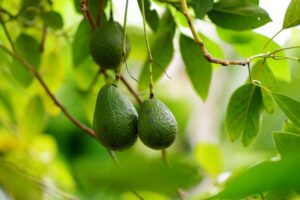
The difference is, while we can catch our own crawfish, you can’t exactly grow avocados in the subtropical swamp that is South Louisiana. So San Diego wins this round, though I’d like to see them try to make a decent crawfish étouffee with avocados. Some culinary boundaries should not be crossed.
The Tuna Years (When San Diego Had a Fishy Past)
From the early 1930s to the late 1970s, San Diego was the tuna capital of the world. This means they were doing with tuna what we do with shrimp, crawfish, and anything else that swims in our waters. The city was full of Portuguese and Italian fishermen who knew their way around the ocean, much like how Baton Rouge folks know their way around a roux.
The tuna industry eventually moved elsewhere, probably to places with worse weather and lower real estate costs, leaving San Diego free to focus on more modern industries like biotechnology, tourism, and making the rest of America feel bad about their weather.
WD-40: The Miracle in a Can
WD-40 was invented in San Diego by the Rocket Chemical Company in 1953. This explains so much. A place with perfect weather and no humidity would naturally invent a product that prevents rust and corrosion, since they probably don’t know what rust looks like. Meanwhile, in Louisiana, we consider WD-40 a food group because everything rusts here within approximately 15 minutes of being manufactured.
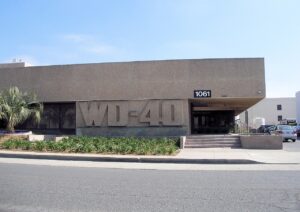
It’s like how people in Alaska invented really good parkas while people in Florida invented air conditioning. Geography is destiny, especially when it comes to useful inventions.
Balboa Park: Cultural Overkill
Balboa Park is 1,200 acres of museums, gardens, theaters, and cultural institutions all crammed into one space. It’s like someone took the entire cultural output of a major metropolitan area and said, “Let’s put it all right here.” Hidden within is the Old Cactus Garden, originally developed in 1935 for the California Pacific International Exposition, which has been quietly showing off for nearly 90 years.
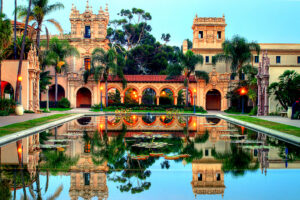
Coming from a state where our idea of a cultural park is usually a festival with live music and food trucks (which, to be fair, is also excellent), Balboa Park feels like cultural overachievement. You could spend a week there and still not see everything, which is either impressive or exhausting, depending on your tolerance for organized enlightenment.
The Beach Situation (Warning: May Cause Smugness)
San Diego has 70 miles of coastline with beaches that look like postcards. The water is clean, the sand is clean, and the lifeguards look like they were cast for a television show about attractive people who save lives. This is the opposite of our Louisiana beaches, which, let’s be honest, are more about the seafood and the party atmosphere than the actual beach experience.
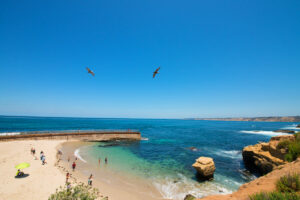
The Pacific Ocean here maintains a temperature that’s refreshing without being shocking, which seems almost unfair. In Louisiana, our water options are either the Gulf (which can be bathwater-warm and full of things that might eat you) or Lake Pontchartrain (which… never mind about Lake Pontchartrain).
Mexican Food (But Make It Californian)
San Diego sits right on the Mexican border, so you’d expect good Mexican food, and you’d be right. However, this is California Mexican food, which means it comes with avocados, sprouts, and a general air of health consciousness that would make a Louisiana cook deeply suspicious.
Don’t get me wrong—the food is delicious. But when someone puts avocado and sprouts on your taco and calls it “fresh and healthy,” those of us raised on red beans and rice have to take a moment to process this information. It’s like discovering that some people exercise for fun instead of just doing physical labor.
The Cost of Paradise (Warning: May Cause Sticker Shock)
The one area where San Diego shows its true California colors is the cost of everything. A modest house costs approximately what a small Louisiana plantation would cost, assuming you could buy a small Louisiana plantation. A cup of coffee costs what we’d pay for a full lunch, and parking downtown costs more per hour than most people in Baton Rouge make in tips.
This is the universe’s way of maintaining balance. Perfect weather and avocados year-round? That’ll be your firstborn child and your retirement savings, please.
The Drive-Through Innovation
The first drive-in restaurant in the United States was opened in San Diego by the man who later founded Jack in the Box in 1951. This is important historical information for those of us from Louisiana, where drive-through daiquiris are considered a basic public service. San Diego invented the drive-in restaurant, we perfected the drive-through cocktail. Different priorities, same innovative spirit.
Final Verdict
San Diego is essentially what happens when you give a city perfect weather, beautiful scenery, and access to unlimited avocados. It’s the meteorological equivalent of winning the lottery, and the residents have the good sense to appreciate it without making too big a deal about it (except for the prices, which suggest they know exactly how good they have it).
For those of us from Louisiana, visiting San Diego is like visiting another planet—one where the weather doesn’t actively try to kill you, where the ocean doesn’t double as a seafood delivery system, and where people put vegetables on their tacos and call it an improvement.
But here’s the thing: despite being the complete opposite of Louisiana in terms of climate, geography, and avocado availability, San Diego has the same laid-back, enjoy-life attitude that we recognize. They just do it in shorts and flip-flops year-round instead of hiding in air conditioning for six months.
Just remember to bring your credit cards. Perfect weather doesn’t come cheap.
Discover more from Baton Rouge Booking
Subscribe to get the latest posts sent to your email.

